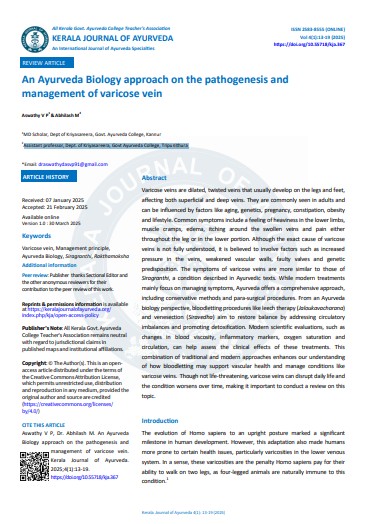An Ayurveda biology approach on the pathogenesis and management of varicose vein
DOI:
https://doi.org/10.55718/kja.367Keywords:
Varicose vein, Management principle, Ayurveda Biology, Siragranthi, RakthamokshaAbstract
Varicose veins are dilated, twisted veins that usually develop on the legs and feet, affecting both superficial and deep veins. They are commonly seen in adults and can be influenced by factors like aging, genetics, pregnancy, constipation, obesity, and lifestyle. Common symptoms include a feeling of heaviness in the lower limbs, muscle cramps, itching around the swollen veins, and pain either throughout the leg or in the lower portion. While varicose veins are not life-threatening, they can significantly impact daily activities, and the condition tends to worsen over time. Although the exact cause of varicose veins is not fully understood, it is believed to involve factors such as increased pressure in the veins, weakened vascular walls, faulty valves, and genetic predisposition. The symptoms of varicose veins are similar to those of Siragranthi, a condition described in Ayurvedic texts. While modern treatments mainly focus on managing symptoms, Ayurveda offers a comprehensive approach, including conservative methods and para-surgical procedures. Para-surgical treatments typically involve Rakthamoksha techniques like Jaloukavacharana (leech therapy) and Siravedha (venesection). This review aims to explore and discuss various aspects of varicose veins and their Ayurvedic management. Though not life-threatening, varicose veins can disrupt daily life, and the condition worsens over time, making it important to conduct a review on this topic.





